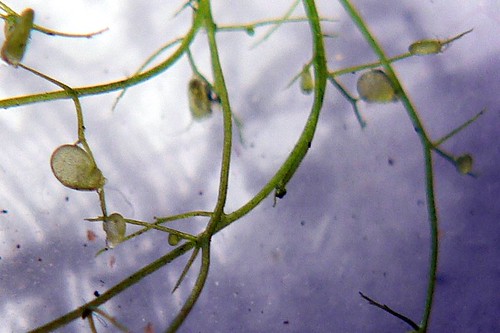I collected some Utricularia gibba ssp. exoleta--Floating Bladderwort--from a dam in Wyee on the NSW Central Coast over a year ago, and have been cultivating it in an open fish-tank in the back garden ever since. Looking at the bladders under the microscope is a wonderful experience, because they're such delicate and efficient structures. They open and draw in some of the surrounding water, then close again to digest the tiny microscopic creatures sucked in with the water. Thus, they're carnivorous plants, but very different from more famous carnivores like the Dionaea muscipula , the Venus Fly Trap.
While I was looking at some today, I found myself wishing that I had a camera attachment for my microscope, and then wondered how it would turn out just with regular macro photography. Quite well, it transpires!
The "stems" are actually stolons, the "shoots" from the stolons are modified leaves, and the bladders grow off the leaves.
To give you a sense of scale, the bladders (or traps) are only 1 to 2.5 mm long.

Ohh. How fascinating. Would something like that grow in Canberra? My children have become fascinated with carniverous plants ever since we watched David Attenboroughs (sp??) Life of Plants.
ReplyDeleteHi Melissa,
ReplyDeleteThere are many species of Utricularia, and I'm sure you'll be able to find one that suits your climate. If you look at Sydney Royal Botanic Gardens' PlantNet entry on Utricularia, you'll see the geographic range of the various species within NSW (including ACT).
Of course, sourcing the species you want might be harder. But you can grow Utricularia inside, in a fishtank. I recently discovered some (I don't know what species) growing in our tropical fishtank. It must have arrived on some water plants we bought at our local aquarium shop.
So even in a place of bitter frosts, your kids can still enjoy it! I do recommend using a stereo microscope to look at it closely, though. But then, what kids wouldn't love a stereo microscope in their lives?! :)